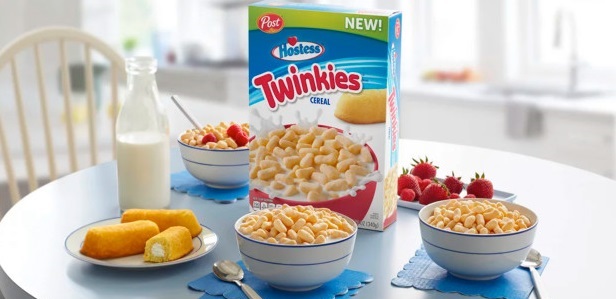The presence of co-branded food product offerings exploded in 2019 across a wide variety of categories. These items from legacy food brands allow companies to enter new food and beverage categories without the need to establish an entirely new brand or product.
The 2019 National Association of Convenience Stores Show previewed upcoming consumer packaged goods releases, several of which included new collaboration products from food companies. Notable launches last year included a Coca-Cola flavor of Tic Tacs, Snack Pack Fanta Gels in three of the soda’s flavors, Starburst-flavored Yoplait yogurt and a huge selection of brand mashup cereals: Post debuted a Twinkies cereal in collaboration with Hostess, General Mills launched branded cereals with several candies including Hershey Kisses and Jolly Rancher and Peeps partnered with Kellogg to release its cereal version.
Brand recognition: Win-win for all
“In developing a cereal version of the iconic Twinkies, our top priority was focused on delivering the great Twinkies flavor in each bite,” Josh Jans, brand manager of cereal partnerships at Post Consumer Brands, said to Food Business News.
The goal of this cereal — and of all brand collaboration food products — is to deliver the taste that consumers are already familiar with, but in the form of a different familiar product. That brand recognition of both taste and product is exactly what appeals to food companies when creating mashup offerings. That brand recognition can also translate into customer loyalty; Consumers who already enjoy Twinkies or Post cereal will likely be more inclined to purchase these collaborations, regardless of the brand’s entrance into a new category.
Beyond the grocery aisle
Food brand mashups aren’t only hitting the grocery aisle — it’s flowing into foodservice as well. Kellogg’s Cheez-It brand partnered with restaurant chain Pizza Hut to create the Stuffed Cheez-It Pizza, a calzone-like menu item featuring a crust made with sharp cheddar Cheez-Its. Chief Brand Officer at Pizza Hut Marianne Radley cited the item as a great grab-and-go option, especially since restaurants have been seeking ways to increase sales of snacks.
The Cheez-It and Pizza Hut hybrid isn’t the only co-branded fast-casual menu item of note: the original viral instance of this product type was Taco Bell’s Doritos Locos Taco. When the taco was introduced in 2012, the chain reportedly sold over a billion units.
“The idea sounds really simple, but it has to deliver on two fronts: the classic Taco Bell taste and the distinctive Doritos experience,” Taco Bell Product Developer Steven Gomez told Business Insider, emphasizing the mashup menu item’s familiarity being incorporated into another product. Consumers want to recognize the flavor and crunch of the Doritos but still have a function Taco Bell taco.
CPG brands even branched into co-branded products outside of food categories in 2019. Ice cream producer Halo Top collaborated with ColourPop Cosmetics this summer to create a makeup collection. AriZona Iced Tea partnered with athletic brand Adidas to create branded sneakers while Cheetos and retailer Forever 21 released a line of snack-inspired clothing.
“Flaming Hot Cheetos fans are so fanatical, and over the past couple of years, we have seen their love for this food illustrated all over pop culture, and in particular, via social media,” Forever 21’s Vice President of Merchandising Linda Chang said in a statement.
The non-food product debuts serve a different purpose from the CPG items you find at a grocery or restaurant; rather than permanently entering a new category — many of the co-branded products are limited-edition — these makeup or clothing offerings often serve a marketing function as well as a new source of revenue.
Brand mashups proved plentiful l in 2019 with CPG companies — as well as restaurants and other non-food brands — harnessing the brand recognition of one another to enter new categories with a built-in customer base.
Related stories:
- Diet trends address consumers’ health, sustainability concerns
- Taking the pulse of online grocery shopping
- How did pumpkin spice become the dominant flavor of fall?
_____________________________________
If you enjoyed this article, sign up for GMA SmartBrief or Restaurant SmartBrief to get news like this in your inbox, or check out all of SmartBrief’s food and travel newsletters as we offer more than 30 newsletters covering the food and travel industries from restaurants, food retail and food manufacturing to business travel, the airline and hotel industries and gaming.
